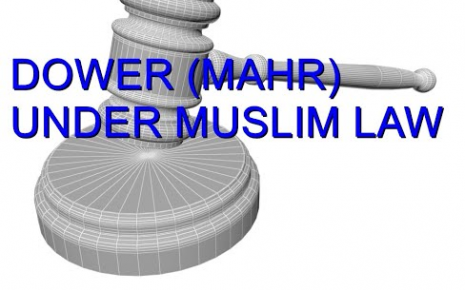School and Source of Muslim Law
Introduction of Muslim Law:
- Muslim law is divine law as opposed to man-made law which is passed by legislatures.
- Concept of oneness of God, unlike Hindus who believe in the plurality of gods.
- Muslims believe that Mohammed was the last Prophet sent by God (Allah) and the Quran is the only revealed book of Allah.
- Muslims acknowledge religious preachers and leaders after Mohammed, but they were not considered prophets.
- Islamic society was not divided on the basis of castes like Hindu society, and everyone was considered equal in the eyes of God.
Origin of Muslim Law:
- The place of Muslim law's origin is Arabia where Mohammad promulgated Islam. Basically, it is of divine origin, meaning Muslim law originates from divinity. It is that law which is established by a communication (Khitab) from God with reference to men's acts, expressing either a demand or indifference on His part or being merely declaratory.
- The entire system of Muslim law, as well as theology, ritual, and private ethics, has been built upon two foundations - the Quran and the traditions (Sunnah & Ahadis). The pre-Islamic customs are hardly referred to by the Muslim jurists for elucidating the law.
Case - Narantakath v. Prakkal (1922):
- It was stated that there are two basic beliefs of Muslims: first, the existence and oneness of God, and second, the belief in the truth of Prophet Mohammed's mission.
About Prophet Mohammed:
- Born in 571 A.D., was raised by grandfather Abdul Muttalib after the death of his mother and father.
- First wife was Kadija, third wife was Aisha (daughter of Abu Bakr).
- Prophet's daughter Fatima married Ali (Prophet's cousin).
- At age 40, when he was meditating in a cave called 'Hira,' he received his first revelation from God (wahi), which was communicated to him by Gabriel (Angel of revelation).
- His first followers were Kadija, Waraqa (a blind scholar), Abu Bakr, Umar, and Usman.
- He faced opposition and was persecuted, humiliated, abused, and dragged by his hair from the temple of Mecca.
- As a result, the Prophet with his followers fled to Medina in 622 AD. This is considered the start of a new era for Arabia and is termed 'Hijrah,' i.e., Migration because in Medina, he formed a political group called 'Umma,' and later there was a war between the supporters and opposers of Mohammed in which Mohammed emerged triumphant and became the supreme religious and political ruler of Arabia, and later many tribes joined his kingdom.
Shia v. Sunni and Schools of Muslim Law:
- Prophet Mohammed died at the age of 63 without leaving an heir to the throne.
- Two groups were formed, which were on a political basis rather than a religious basis:
- Group one wanted 'Ali' to be the successor (Shia).
- Group two wanted an election (Sunnis).
Sunni Schools
In Sunni sect, there are four major schools of Muslim law which are as follows:Hanafi School
Hanafi School is the first and the most popular schools in Muslim law. Before being named Hanafi, this school was known as Koofa School which was based on the name of the city of Koofa in Iraq. Later, this school was renamed as Hanafi School based on the name of its founder Abu Hanafee.The Prophet had not allowed his words and traditions from being written, the Hanafi School relied on the customs and decisions of the Muslim community. Thus, Hanafi School codified the precedent which in prevalence during that time among the Muslim community.
The founder of this school Abu Hanafee had not written any book for laying down the rules of this school and therefore this school had grown through his two disciples- Imam Muhammed and Imam Abu Yousuf. Both of them gave to the Juristic preference (Isthi Hasan) and codified the Ijma's of that period.
Maliki School
This school gets its name from Malik-bin-Anas, he was the Mufti of Madeena. During his period the Khoofa was considered as the capital of Muslim Khaleefa where Imam Abu Haneefa and his disciples flourished with Hanafi Schools. He discovered about 8000 traditions of Prophet but complied only about 2000 of them. When the disciples of Imam Abu Haneefa codified their law based on Ijma'a and Isthihsan.The maliki school gives the importance to the Sunna and Hadis whereas the Hanafi school gives the importance to the people and Isthihsan. As per Maliki School and Law, they rarely accept the Ijma'a. As per the Law, the person gave Fatwa challenging the sovereign authority of Khaleefa, he faced enmity and of lack of support from Muslim governments. Thus, this Maliki school did not get much popularity.
Shaffie School
The Shaffie School gets its name on the name of Muhammad bin Idris Shaffie, his period was between 767 AD to 820 AD. He was the student of Imam Malik of Madeena. Then he started working with the disciples of Imam Abu Haneefa and went to Khoofa.He conclude the idea's and the theories of Hanafi School and Maliki School in a friendly manner. The Imam Shaffie was considered as one of the greatest jurist of Islam. He created the classical theory of the Shaffie Islamic Jurisprudence.
According to this school, they considered Ijma'a as the important source of the Muslim law and provide validity to the customs of the Islamic people and follows more methods of Hanafi School. the main contribution of Shaffie School is the Quiyas or Analogy.
Hanbali School
The Ahmad bin Hanbal is the founder of the Hanbali School. He found the Hanbali school in 241 (AD 855). He is the disciple of Imam Shaffie and supports Hadis. He strongly opposed the Ijthihad methods. He introduced the theory of tracing the root of Sunna and Hadis and try to get the answer all his question. His theory was to return to the Sunna of the Prophet. When the Imam Shafie left for Baghdad, he declared that the Ahmad bin Hanbal was the only one after him who is the better jurist after him. The followers of Hanbali school found in Syria, Phalastine and Saudi Arabia.Shia Schools
As per Shia Sect, there are three schools of law. Shia Sect is considered as the minority in the Muslim world. They enjoy the political power only in Iran though they don't have the majority in that state also.- Ithna-Asharis
These schools are based on the following of Ithna-Ashari laws. The followers of these schools are mostly found in Iraq and Iran. In India also there is the majority of the shia muslim who follows the principles of the Ithna-Asharis School. They are considered political quietists. This school is considered as the most dominant school of the shia muslims. the ja'fari fiqh of the shias in most cases indistinguishable from one or more of the four sunni madhahib, except mutah is considered as the lawful marriage. The people who follow the Ithna Asharis school believe that the last of the Imams disappeared and to be returning as Mehdi(Messiah).
- The Ismailis
According to Ismailis school, in India there are two groups, the Khojas or Western Ismailis represents the followers of the present Aga Khan, who they considered as the 49th Imam in this line of Prophet, and the Bohoras i.e. the Western Ismailis are divided into Daudis and Sulaymanis.
The Bohoras and Khojas of Mumbai are considered as the followers of this school. It is considered that the follower of these schools has special knowledge of religious doctrine.
- The Quran (Koran):
- Derived form the Arabic word 'Quarra' which means 'to read'.
- Collected and arranged by Abu Bakar (1st Khalifa) and revised by Usman (3rd Khalifa).
- Communicated to Prophet by Gabriel (Angel of revelation) in form of messages (wahi) over 23 years.
- Around 6000 verses out of which 200 deals with legal principles such as marriage, matrimonial remedies, maintenance, acknowledgement of paternity, transfer of property, gift, wills, inheritance etc.
- Abolished objectionable customs like female infanticide, gambling, usury (practise of lending money at unreasonable high interest of minors and disabled and for overall increasing the status of women were also there.
- The Sunnah (Sunnat) - the path:
- Second source of Muslim Law
- Whatever the prophet said, did or allowed tacitly is called 'hadis' (traditions)
- Whatever the prophet said in words- 'Sunnat-ul-qual'
- Whatever he did- 'Sunnat-ul-fail'
- Whatever he allowed to be done without actually saying it (tacitly)- 'Sunnat-ul-tuqrir'
- These Sunnats could be manipulated as they were not certain as the 'quran' and used as a political weapon which happened during the rule of Umayyad dynasty so these sunnats were collected and compiled by various people and these collection were called 'Musnads'
- Consensus (Ijmaa):
- Consensus of the most learned members of the community.
- This source has been validated both the Quran and the Prophet (via Sunnat)
- Qiyas (Shia don't recognize it):
- Collection of rules and principles deductible by the methods of analogy and interpretation from the Quran Sunnat and Ijmaa.
- Shia believe that if the scope of law has to be widened it should be only done by imam and no one else.
- Legislation:
- Though most of Muslim law is not codified but some of it is codified like Shariat Act, 1937:
- Dissolution of Muslim Marriage Act,1939
- The Muslim Women (Protection of Rights on Divorce) Act,1985
- The Muslim Women (Protection of Rights on Marriage) Act,2019
- Customs and usages having the force of law:
- This is the second secondary source of Muslim Law. The customs are now regarded as a legitimate source of Muslim Law but they are considered inferior in position hierarchically after Quran, Sunnah, Ijma, and Superior to Qiyas.
This is the second secondary source of Muslim Law. The custom are now regarded as a legitimate source of Muslim Law but they are considered inferior in position hierarchically after Quran, Sunnah, Ijma and Superior to Qiyas.
Judicial Decision
This is the third secondary source of Muslim law. It may be a decision of the privy council, the Supreme Court and high court of India are regarded as a precedent for future cases.
Justice, Equity and good conscience
The doctrine of justice, equity and good conscience is the fourth secondary sources of Muslim Law. The rule of law is based here on the analogy that could be set aside at the option of a judge on a liberal construction or juristic preference to meet the requirement of a particular case.
Conclusion
Muslim law is an integral element of Indian laws and must be understood and implemented in the similar manner as any other law in the country. Despite the fact that most of it is uncodified, Muslim personal law has the same legal significance in India as other religions' codified personal laws, such as the Hindu Marriage Act of 1955 and the Christian Marriage Act of 1872.
The Hon'ble Supreme Court of India has taken into account that women's rights are not being neglected or discriminated against on any grounds by delivering progressive judgments. This has developed in contribution to Muslim law to have a newer perspective with the landmark cases. Adding more to this, the judgments have set up a platform of a level playing field and thus, leading to the formation of an egalitarian society.
Law Article in India
Legal Question & Answers
Lawyers in India - Search By City
LawArticles
How To File For Mutual Divorce In Delhi

How To File For Mutual Divorce In Delhi Mutual Consent Divorce is the Simplest Way to Obtain a D...
Increased Age For Girls Marriage

It is hoped that the Prohibition of Child Marriage (Amendment) Bill, 2021, which intends to inc...
Facade of Social Media

One may very easily get absorbed in the lives of others as one scrolls through a Facebook news ...
Section 482 CrPc - Quashing Of FIR: Guid...

The Inherent power under Section 482 in The Code Of Criminal Procedure, 1973 (37th Chapter of t...
The Uniform Civil Code (UCC) in India: A...

The Uniform Civil Code (UCC) is a concept that proposes the unification of personal laws across...
Role Of Artificial Intelligence In Legal...

Artificial intelligence (AI) is revolutionizing various sectors of the economy, and the legal i...








Please Drop Your Comments